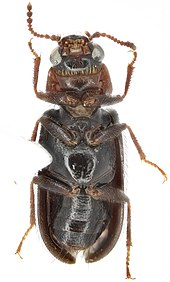Acanthocnemus
| Acanthocnemus | |
|---|---|
 | |
 | |
| Scientific classification | |
| Domain: | Eukaryota |
| Kingdom: | Animalia |
| Phylum: | Arthropoda |
| Class: | Insecta |
| Order: | Coleoptera |
| Suborder: | Polyphaga |
| Infraorder: | Cucujiformia |
| Superfamily: | Cleroidea |
| Family: | Acanthocnemidae Crowson, 1970 |
| Genus: | Acanthocnemus Perris, 1867 |
| Species: | A. nigricans |
| Binomial name | |
| Acanthocnemus nigricans (Hope, 1843[1]) | |
Acanthocnemus nigricans is a species of cleroid beetle, the only species in the genus Acanthocnemus and the family Acanthocnemidae. Originally native to Australia, the species has spread in modern times to numerous parts of the world, including Europe, Africa, India and Southeast Asia. The insects are pyrophilous, congregating around areas of recently burned wood, being attracted to chemicals found in wood smoke.[2][3] They have specialised infrared receptors located on the thorax close to the head, used to detect heat. Their life cycle is poorly understood, though mating and egg-laying likely occurs within ash.[4] The larvae are possibly saprophagous.[3]
References
- ^ Hope, F. W. 1843. Descriptions of new species of insects collected at Adelaide in South-Western Australia by Mr. Fortnum. Proceedings of the Entomological Society for June 6, 1842. The Annals and Magazine of Natural History (70) 11: 317–319
- ^ Paczkowski, Sebastian; Paczkowska, Marta; Dippel, Stefan; Flematti, Gavin; Schütz, Stefan (March 2014). "Volatile Combustion Products of Wood Attract Acanthocnemus nigricans (Coleoptera: Acanthocnemidae)". Journal of Insect Behavior. 27 (2): 228–238. doi:10.1007/s10905-013-9430-4. ISSN 0892-7553. S2CID 254701199.
- ^ a b Lawrence, John F. and Leschen, Richard A. B.. "9.7. Acanthocnemidae Crowson, 1964". Volume 2 Morphology and Systematics (Elateroidea, Bostrichiformia, Cucujiformia partim), edited by Willy Kükenthal, Richard A.B. Leschen, Rolf G. Beutel and John F. Lawrence, Berlin, New York: De Gruyter, 2011, pp. 262-265.
- ^ Zhou, Zupeng; Gong, Yubing; Yang, Daoguo; Schmitz, Anke; Schmitz, Helmut (December 2016). "Function modeling of the infrared organ of "Little Ash Beetle" Acanthocnemus nigricans (Coleoptera, Acanthocnemidae)". Journal of Bionic Engineering. 13 (4): 650–658. doi:10.1016/S1672-6529(16)60336-0. ISSN 1672-6529. S2CID 89072728.
- Lobl, I.; Smetana, A., eds. (2007). Catalogue of Palaearctic Coleoptera, Volume 4: Elateroidea - Derodontoidea - Bostrichoidea - Lymexyloidea - Cleroidea - Cucujoidea. Apollo Books. ISBN 978-8788757675.
External links
 Data related to Acanthocnemus at Wikispecies
Data related to Acanthocnemus at Wikispecies
- v
- t
- e
- Kingdom: Animalia
- Phylum: Arthropoda
- Class: Insecta
- Subclass: Pterygota
- Infraclass: Neoptera
- Superorder: Holometabola
Suborder Archostemata | |
|---|---|
|
Suborder Adephaga | |||
|---|---|---|---|
| |||
Suborder Myxophaga | |
|---|---|
|
Suborder Polyphaga | |||||||||||||||||||||||||||||||||||||||||||||||||
|---|---|---|---|---|---|---|---|---|---|---|---|---|---|---|---|---|---|---|---|---|---|---|---|---|---|---|---|---|---|---|---|---|---|---|---|---|---|---|---|---|---|---|---|---|---|---|---|---|---|
| |||||||||||||||||||||||||||||||||||||||||||||||||
 | This Cleroidea-related article is a stub. You can help Wikipedia by expanding it. |
- v
- t
- e











